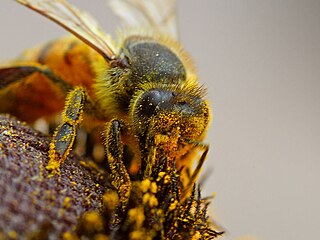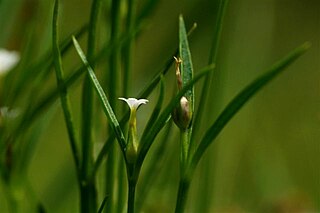Related Research Articles

Sex is the trait that determines whether a sexually reproducing animal or plant produces male or female gametes. Male plants and animals produce small mobile gametes, while females produce larger, non-motile ones. Organisms that produce both types of gametes are called hermaphrodites. During sexual reproduction, male and female gametes fuse to form zygotes, which develop into offspring that inherit traits from each parent.

Fertilisation or fertilization, also known as generative fertilisation, syngamy and impregnation, is the fusion of gametes to give rise to a new individual organism or offspring and initiate its development. While processes such as insemination or pollination which happen before the fusion of gametes are also sometimes informally referred to as fertilisation, these are technically separate processes. The cycle of fertilisation and development of new individuals is called sexual reproduction. During double fertilisation in angiosperms the haploid male gamete combines with two haploid polar nuclei to form a triploid primary endosperm nucleus by the process of vegetative fertilisation.

Amborella is a monotypic genus of understory shrubs or small trees endemic to the main island, Grande Terre, of New Caledonia in the southwest Pacific Ocean. The genus is the only member of the family Amborellaceae and the order Amborellales and contains a single species, Amborella trichopoda. Amborella is of great interest to plant systematists because molecular phylogenetic analyses consistently place it as the sister group to all other flowering plants.

The Bryophyta s.l. are a proposed taxonomic division containing three groups of non-vascular land plants (embryophytes): the liverworts, hornworts and mosses. Bryophyta s.s. consists of the mosses only. They are characteristically limited in size and prefer moist habitats although they can survive in drier environments. The bryophytes consist of about 20,000 plant species. Bryophytes produce enclosed reproductive structures, but they do not produce flowers or seeds. They reproduce sexually by spores and asexually by fragmentation or the production of gemmae. Though bryophytes were considered a paraphyletic group in recent years, almost all of the most recent phylogenetic evidence supports the monophyly of this group, as originally classified by Wilhelm Schimper in 1879. The term bryophyte comes from Ancient Greek βρύον (brúon) 'tree moss, liverwort', and φυτόν (phutón) 'plant'.

Gentianaceae is a family of flowering plants of 103 genera and about 1600 species.

Sequential hermaphroditism is a type of hermaphroditism that occurs in many fish, gastropods, and plants. Sequential hermaphroditism occurs when the individual changes its sex at some point in its life. In particular, a sequential hermaphrodite produces eggs and sperm at different stages in life. Species that can undergo these changes from one sex to another do so as a normal event within their reproductive cycle that is usually cued by either social structure or the achievement of a certain age or size.

Entomophily or insect pollination is a form of pollination whereby pollen of plants, especially but not only of flowering plants, is distributed by insects. Flowers pollinated by insects typically advertise themselves with bright colours, sometimes with conspicuous patterns leading to rewards of pollen and nectar; they may also have an attractive scent which in some cases mimics insect pheromones. Insect pollinators such as bees have adaptations for their role, such as lapping or sucking mouthparts to take in nectar, and in some species also pollen baskets on their hind legs. This required the coevolution of insects and flowering plants in the development of pollination behaviour by the insects and pollination mechanisms by the flowers, benefiting both groups.

Corsiaceae is a family of monocotyledonous flowering plants. The APG II system (2003) treats the family in the order Liliales, in the clade monocots. This is a slight change from the APG system, of 1998, which left the family unplaced as to order, but did assign it also to the monocots.
The mechanisms of reproductive isolation are a collection of evolutionary mechanisms, behaviors and physiological processes critical for speciation. They prevent members of different species from producing offspring, or ensure that any offspring are sterile. These barriers maintain the integrity of a species by reducing gene flow between related species.

Ecological light pollution is the effect of artificial light on individual organisms and on the structure of ecosystems as a whole.

Sebaea is a genus of annual plants in the family Gentianaceae. Species occur in Africa, Madagascar, India, China, Thailand, Australia and New Zealand. The genus was paraphyletic and has been split in four genera: Exochaenium, Klackenbergia, Lagenias and Sebaeas.str.. Synapomorphies for Sebaea s.str. include the presence of extra stigma along the style and the shape of the testa cells of the seeds.
Inbreeding avoidance, or the inbreeding avoidance hypothesis, is a concept in evolutionary biology that refers to the prevention of the deleterious effects of inbreeding. Animals only rarely exhibit inbreeding avoidance. The inbreeding avoidance hypothesis posits that certain mechanisms develop within a species, or within a given population of a species, as a result of assortative mating, natural and sexual selection in order to prevent breeding among related individuals in that species or population. Although inbreeding may impose certain evolutionary costs, inbreeding avoidance, which limits the number of potential mates for a given individual, can inflict opportunity costs. Therefore, a balance exists between inbreeding and inbreeding avoidance. This balance determines whether inbreeding mechanisms develop and the specific nature of said mechanisms.

In behavioral ecology, polyandry is a class of mating system where one female mates with several males in a breeding season. Polyandry is often compared to the polygyny system based on the cost and benefits incurred by members of each sex. Polygyny is where one male mates with several females in a breeding season . A common example of polyandrous mating can be found in the field cricket of the invertebrate order Orthoptera. Polyandrous behavior is also prominent in many other insect species, including the red flour beetle and the species of spider Stegodyphus lineatus. Polyandry also occurs in some primates such as marmosets, mammal groups, the marsupial genus' Antechinus and bandicoots, around 1% of all bird species, such as jacanas and dunnocks, insects such as honeybees, and fish such as pipefish.

The genus Exochaenium is endemic to sub-Saharan Africa, with species occurring in most tropical and sub-tropical regions of the continent, particularly on the Katanga plateau, with many extending to the Sudano-Zambesian and Guineo-Congolian regions. The genus is monophyletic and is used to study the variation and evolution of herkogamy.

Klackenbergia is a genus of flowering plants belonging to the gentian family (Gentianaceae) and the tribe Exaceae. It only contains two species, both endemic to Madagascar. They are notable for their inflorescence with characteristic long bracts and bracteoles and sub-sessile flowers arranged in axillary fascicules at each node.

Exaceae is a flowering plant tribe in the family Gentianaceae. Exaceae comprises about 180 species assigned to eight monophyletic genera, with major centres of endemism in continental Africa, Madagascar and the southern tip of India and Sri Lanka (14 endemic species).

Silene is a flowering plant genus that has evolved a dioecious reproductive system. This is made possible through heteromorphic sex chromosomes expressed as XY. Silene recently evolved sex chromosomes 5-10 million years ago and are widely used by geneticists and biologists to study the mechanisms of sex determination since they are one of only 39 species across 14 families of angiosperm that possess sex-determining genes. Silene are studied because of their ability to produce offspring with a plethora of reproductive systems. The common inference drawn from such studies is that the sex of the offspring is determined by the Y chromosome.

Reinforcement is a process within speciation where natural selection increases the reproductive isolation between two populations of species by reducing the production of hybrids. Evidence for speciation by reinforcement has been gathered since the 1990s, and along with data from comparative studies and laboratory experiments, has overcome many of the objections to the theory. Differences in behavior or biology that inhibit formation of hybrid zygotes are termed prezygotic isolation. Reinforcement can be shown to be occurring by measuring the strength of prezygotic isolation in a sympatric population in comparison to an allopatric population of the same species. Comparative studies of this allow for determining large-scale patterns in nature across various taxa. Mating patterns in hybrid zones can also be used to detect reinforcement. Reproductive character displacement is seen as a result of reinforcement, so many of the cases in nature express this pattern in sympatry. Reinforcement's prevalence is unknown, but the patterns of reproductive character displacement are found across numerous taxa, and is considered to be a common occurrence in nature. Studies of reinforcement in nature often prove difficult, as alternative explanations for the detected patterns can be asserted. Nevertheless, empirical evidence exists for reinforcement occurring across various taxa and its role in precipitating speciation is conclusive.
Reproductive assurance occurs as plants have mechanisms to assure full seed set through selfing when outcross pollen is limiting. It is assumed that self-pollination is beneficial, in spite of potential fitness costs, when there is insufficient pollinator services or outcross pollen from other individuals to accomplish full seed set.. This phenomenon has been observed since the 19th century, when Darwin observed that self-pollination was common in some plants. Constant pollen limitation may cause the evolution of automatic selfing, also known as autogamy. This occurs in plants such as weeds, and is a form of reproductive assurance. As plants pursue reproductive assurance through self-fertilization, there is an increase in homozygosity, and inbreeding depression, due to genetic load, which results in reduced fitness of selfed offspring. Solely outcrossing plants may not be successful colonizers of new regions due to lack of other plants to outcross with, so colonizing species are expected to have mechanisms of reproductive assurance - an idea first proposed by Herbert Baker and referred to as Baker's Law. Baker’s Law predicts that reproductive assurance should be common in weedy plants that persist by colonizing new sites. As plants evolve towards increase self-fertilization, energy is redirected to seed production rather than characteristics that increased outcrossing, such as floral attractants, which is a condition known as the selfing syndrome.
References
- ↑ Marloth, R. (1909). "A diplostigmatic plant, Sebaea exacoides (L.) Schinz (Belmontia cordata L.)". Transactions of the Royal Society of South Africa. 1: 311–314. doi:10.1080/00359190909520037.
- ↑ Kissling, Jonathan; Endress, Peter K.; Bernasconi, Giorgina (2009). "Ancestral and monophyletic presence of diplostigmaty in Sebaea (Gentianaceae) and its potential role as a morphological mixed mating strategy" (PDF). New Phytologist. 184 (2): 303–310. doi:10.1111/j.1469-8137.2009.03000.x. PMID 19796337. S2CID 21437269.
- ↑ Kissling, Jonathan; Barrett, Spencer C.H. (2013). "Diplostigmaty in plants: a novel mechanism that provides reproductive assurance". Biology Letters. 9 (5): 20130495. doi:10.1098/rsbl.2013.0495. PMC 3971688 . PMID 23945209.